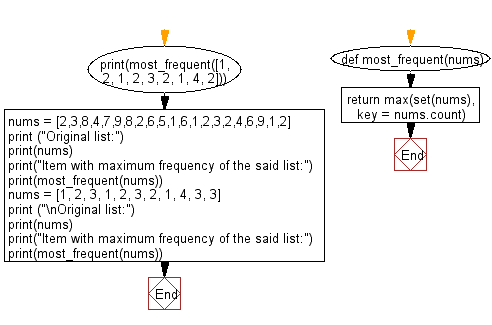Python: Most frequent element in a given list of numbers
Most Frequent Element in List
Write a Python program to get the most frequent element in a given list of numbers.
- Use set() to get the unique values in nums.
- Use max() to find the element that has the most appearances.
Sample Solution:
Python Code:
# Define a function named 'most_frequent' that finds the most frequently occurring item in a list.
def most_frequent(nums):
return max(set(nums), key=nums.count)
# Using 'set' to remove duplicates, then finding the item with the maximum count using the 'max' function.
# Test the 'most_frequent' function with different lists.
print(most_frequent([1, 2, 1, 2, 3, 2, 1, 4, 2]))
# Find the most frequently occurring item in the list. (Expected output: 2)
nums = [2, 3, 8, 4, 7, 9, 8, 2, 6, 5, 1, 6, 1, 2, 3, 2, 4, 6, 9, 1, 2]
print("Original list:")
print(nums)
print("Item with the maximum frequency of the said list:")
print(most_frequent(nums))
# Find the most frequently occurring item in the list.
nums = [1, 2, 3, 1, 2, 3, 2, 1, 4, 3, 3]
print("\nOriginal list:")
print(nums)
print("Item with the maximum frequency of the said list:")
print(most_frequent(nums))
# Find the most frequently occurring item in the list.
Sample Output:
2 Original list: [2, 3, 8, 4, 7, 9, 8, 2, 6, 5, 1, 6, 1, 2, 3, 2, 4, 6, 9, 1, 2] Item with maximum frequency of the said list: 2 Original list: [1, 2, 3, 1, 2, 3, 2, 1, 4, 3, 3] Item with maximum frequency of the said list: 3
Flowchart:

For more Practice: Solve these Related Problems:
- Write a Python program to find the top two most frequent elements in a list along with their counts.
- Write a Python program to determine if the most frequent element appears more than half the time in a list.
- Write a Python program to find the most frequent element among those that occur at even indices.
- Write a Python program to get the most frequent element from a list after filtering out values below a given threshold.
Go to:
Previous: Write a Python program to check if a given function returns True for at least one element in the list.
Next: Write a Python program to move the specified number of elements to the end of the given list.
Python Code Editor:
What is the difficulty level of this exercise?
Test your Programming skills with w3resource's quiz.
